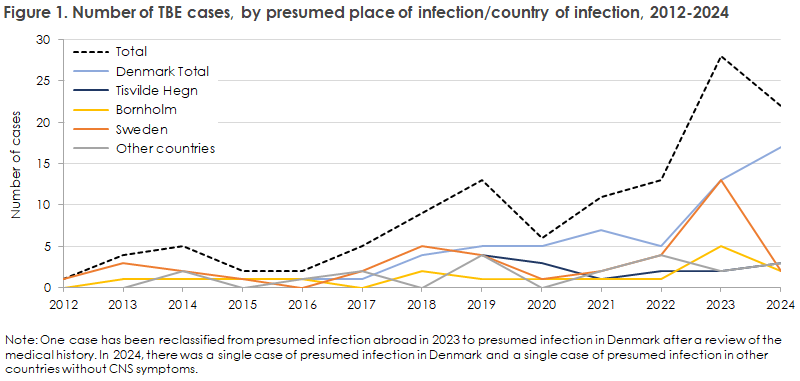No 10/11 - 2025
Tick-borne encephalitis (TBE) detected in Denmark in 2024
Tick-borne encephalitis (TBE) detected in Denmark in 2024
Tick-borne encephalitis (TBE), also known as Central European encephalitis, is a viral infection transmitted to humans via tick bites. The disease can cause flu-like symptoms and, in some cases, can develop into encephalitis, particularly among adults/elderly individuals. In Denmark, the number of registered TBE cases has slightly decreased from 28 in 2023 to 22 in 2024, primarily due to fewer infections from Sweden. However, there is a slight increase in the number of cases with suspected infection in Denmark and a spread to new geographical areas within the country.
Since November 2023, TBE has been laboratory-notifiable to Statens Serum Institut (SSI), which compiles an annual report on the occurrence of TBE detected in Denmark. This annual report covers 2024. For a detailed review of the infection cases, refer to the Annual Report on TBE in 2024.
Overall decrease in 2024 but increase in cases with suspected infection in Denmark
The number of diagnosed TBE cases with suspected infection in Denmark has been increasing since 2018. Although the numbers remain small, the trend continues to rise, with 17 cases in 2024 suspected to have been infected in Denmark, compared to 13 confirmed cases in 2023 (see Figure 1).

Of the 17 Danish TBE cases in 2024, two were suspected to have been infected in Bornholm, fourteen in Zealand – primarily in North Zealand, but also one case from West Zealand (Odsherred) – and one case in Jutland in the Randers area.
As in previous years, 2024 saw a further geographical spread to new municipalities with areas classified as possible infection zones. For example, in 2024, two cases were found in Egedal Municipality (Ganløse Ore/Egede), one case in Odsherred Municipality (Veddinge Bakker), and one case in Randers Municipality (Fussing Sø).
TBE virus detected at SSI in ticks collected in Jonstrup Vang
In 2024, two human TBE cases were identified with a possible infection site in the part of Hareskoven surrounding Søndersø, i.e., the Jonstrup Vang forest area. Since GPS tracking allowed for a very precise indication of one patient’s movements in Jonstrup Vang before symptom onset, a flagging procedure was subsequently conducted, meaning ticks were collected in the area.
Two areas in Jonstrup Vang were flagged, and the collected ticks were tested for the TBE virus in October 2024. In one area, TBE virus was detected in the ticks, with a prevalence of 0.86%. After a follow-up flagging to confirm the original finding, the area remained positive for the TBE virus in November 2024 with a prevalence of 0.3%. Genomic characterization from whole-genome sequencing of the findings from Jonstrup Vang indicates that this is a separate introduction of the TBE virus, likely from Central Europe.
Prevention of TBE
In a risk assessment from December 2023, SSI anticipated that in the coming years, more cases of TBE would be observed, along with a spread to new areas in Denmark. However, it is important to emphasize that the infection remains rare in Denmark.
One can protect against the TBE virus by either attempting to avoid tick bites, promptly removing ticks, and/or getting vaccinated if one frequently moves through forests and dense vegetation outside of trails from May to October or picks up ticks even when staying on trails in known TBE risk areas. This may be particularly relevant for individuals such as orienteers, forestry workers, and mushroom and berry pickers who frequent known risk areas during the risk period. However, it is essential to be aware that vaccination does not provide 100% protection. Conversely, vaccination will still not be relevant for the vast majority of forest visitors.
(P.H. Andersen, A.V. Søndergaard, L.S. Vestergaard, Department of Infectious Disease Epidemiology and Prevention, R. Lassaunière, C.P. Strandh, M. Rasmussen, K. Franck, U.V. Schneider, Virus and Microbiological Special Diagnostics)